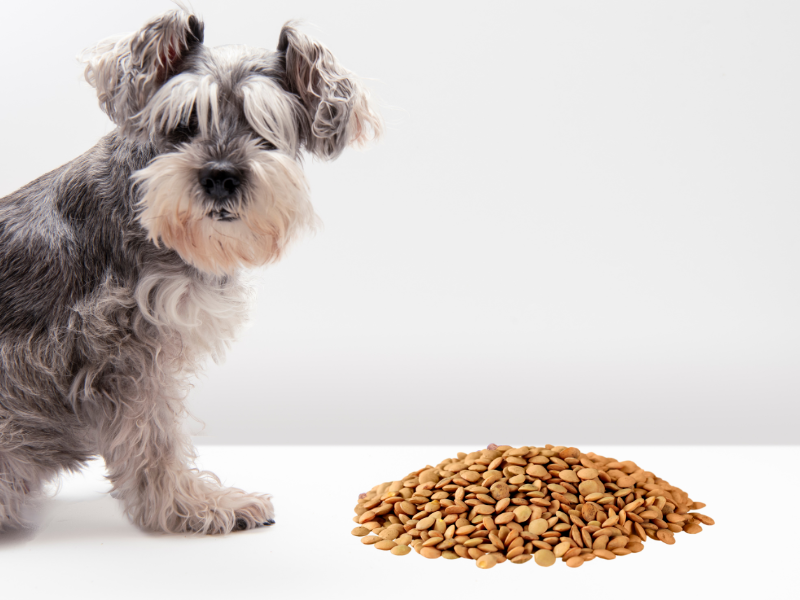Lentils have been a staple ingredient in the diet of humans for generations now, being included in soups, dips, and various other dishes. Vegans and vegetarians, in particular, swear by lentils and the world of nutritional goodness they contain.
As a pet owner, however, have you ever wondered, “Can dogs eat lentils?” Being a part of the family of legumes, much like beans and peas, these are easily available at stores, and even more so in the health section as they are filled with fiber, protein, and iron.
Lentils are not consumed in their fresh form; instead, they are eaten after being soaked properly and then cooked. The various types of colors differentiate one kind of lentil from another, such as yellow, green, red, black, and so on.
They are all used in numerous kinds of dishes, with each of them possessing unique characteristics.
Have you been thinking of feeding lentils to your dog but aren’t sure of its pros and cons? Well, we are here to help you out with that thought.
In this article, we will dive deep into whether dogs can eat lentils, what their benefits and risks are, how they can consume them, and much more.
Are Lentils Safe for Dogs?
When lentils are included in a well-balanced diet for dogs, your pet can derive the benefits that come from their nutritious qualities, making them safe for your furry friend.
Suppose you feed it to your dog in moderation. In that case, the solid elements, such as fiber, protein, iron, and other essential minerals, can contribute to the overall diet of your canine companion.
Always remember that most of the meals given to a dog should include dog-specific food, with just 10% of it being other food items, including human food safe for dogs.
Much like other human foods, a dog could be allergic to lentils. Therefore, monitoring their health and behavior is imperative in such cases. Whenever you think of incorporating dog-safe human food into your pet’s diet, seek a veterinarian’s advice first.
So, the next time someone asks you, “Can dogs eat lentils?” let them know that the answer is yes, and insist that they do so in a balanced manner.
Do Lentils Have Any Health Benefits for Dogs?
When lentils are taken in a cup, we know they contain zinc, potassium, phosphorus, magnesium, calcium, fiber, protein, carbohydrates, iron, folate, and vitamin B6.
Here are some of the reasons why lentils can be beneficial to dogs:
1. High on Fiber
Lentils are extremely rich in fiber, aiding in soothing constipation and regulating your dog’s digestive system. Due to the fiber present, your dog will feel full, which could also help them lose weight in case they are suffering from obesity.
2. Nutritional Value
Along with fiber, lentils are also packed with protein, and the combination of these two ensures to keep a dog’s blood sugar level in check. The reason lentils are named in the category of superfoods is because of all the goodness they pack in.
The different types of vitamin B along with the iron keeps them energized and the potassium is fantastic for the health of their heart. The folate in it assists in producing red blood cells and boosts your dog’s metabolism.
While the omega-6 fatty acids amplify their immunity, the amino acids make their muscles and skin healthier.
3. Low on Sugar
The low glycemic (low GI) of lentils means that their sugar content is low. Therefore, it won’t prove to be too sugary for your pet and will also help diabetic dogs by not further raising their blood sugar level.
What are the Potential Risks of Feeding Lentils to Dogs?
When it comes to non-traditional dog food, there are two sides to the story, and it’s wise and essential to be aware of both the pros and cons before introducing a new food item to your dog.
The following are a couple of the potential risks associated with lentils that you should know about:
1. Digestive Issues
Your dog’s digestive system could get affected negatively as well when it comes to the fiber content in lentils. This entails that if a dog consumes lentils in huge quantities, it can lead to an upset tummy, bloating, flatulence, and also loose stools.
2. Side Effects of Phytate and Lectin
Lentils contain phytate, also known as phytic acid, and these can prevent a dog’s body from absorbing nutrients, leading to them facing mineral deficiencies.
Lectins refer to proteins found in lentils, which aren’t easy for a dog’s gut to digest, which is why it is important to break the lectins down by boiling the lentils. If not broken down through cooking, lectins can prove to be very harmful to your four-legged buddy.
When a dog’s body breaks down lectins, it can cause them to become very gassy. Thus, if dogs do not eat lentils properly digestible, lectins will move around their system, leading to joint pain, rashes, diarrhea, vomiting, and an inflamed gut.
3. Chances of Heart Disease
The United States Food and Drug Administration (FDA) found a link between dogs developing canine dilated cardiomyopathy or CDM and certain types of commercial dog food.
Canine dilated cardiomyopathy is a dangerous heart disease among dogs, and the investigation is ongoing. Certain examples of these grain-free dog food include lentils, peas, and other items in the legume category.
Although no solid evidence has been discovered so far to prove that the CDM was caused due to the aforementioned food items, dog owners often keep their pets away from lentils just as a precautionary measure.
How to Serve Lentils to Your Dog?

After doing your research, you could be thinking to yourself about the ways in which you can safely introduce lentils into your pet’s diet. Before serving lentils to your dog, just keep the following points in mind:
- Talk to your vet and get all the medically sound information regarding the advantages and disadvantages of lentils. Make sure to ask them regarding the quantity of lentils to feed to your dog. If you plan to cook lentils the next day, keep them soaked in water overnight. The phytates and lectins in lentils disappear once they are soaked efficiently. This also softens them, makes it easy for your dog to digest them, and also ensures your pet doesn’t choke on them.
- If you plan to cook lentils the next day, keep them soaked in water overnight. The phytates and lectins in lentils disappear once they are soaked efficiently. This also softens them, makes it easy for your dog to digest them, and also ensures your pet doesn’t choke on them.
- Remember that lentils are a treat for your doggo and not the primary ingredient in their daily diet. Including just a tablespoon of cooked lentils once or twice a week into their kibble is sufficient enough.
- A tip for dog owners to remember is that lentils should be served completely plain without including salt, sugar, or any other type of seasoning. Do not go for lentil chips or lentil soup, and opt only for the pure, cooked form. For instance, the onion in lentil soup is toxic to dogs.
- Introducing a new kind of food to your dog automatically means that their behavior needs to be monitored accordingly. Start with small quantities and bring them to a moderate amount only once you are sure that their body is not reacting adversely to lentils.
What Type of Lentils Can Dogs Eat?
With so many different types of lentils available in the market, it can be tricky to determine what you can feed to your dog.
Brown lentils are an extremely common option when it comes to feeding lentils to dogs. Once they are cooked, they form a creamy texture, which your pet can easily swallow.
Red lentils are the go-to option for most humans as it forms a nutty and sweet taste in our mouths. Much like brown lentils, these are safe for dogs. If you’re thinking of giving red lentils to your dog and including them on your plate, feel free to do so.
The quantity of fiber in red lentils is lower than in brown lentils.
Green lentils are an option for dogs too. The only thing to remember is that they take longer to be cooked, with the positive aspect being that they are packed with minerals and antioxidants. However, your dog could reject it if they don’t prefer a peppery flavor in their meals.
FAQ’s
Q1. Are lentils toxic to dogs?
Ans. No, lentils are not toxic and can be fed to dogs. They form a part of many commercially sold dog food brands. However, much like anything else, they should be fed to dogs in moderate quantities.
Q2. Can dogs be allergic to lentils?
Ans. There could be a possibility for your dog to be allergic to lentils or possess a low tolerance for them. However, this is quite rare. Monitor your dog’s health properly once you start feeding them lentils, and discontinue if you see any adverse reactions.
Q3. Are lentils better than rice for dogs?
Ans. Yes, lentils are better than rice for dogs. This is because, compared to brown and white rice, lentils contain more iron, fiber, and protein.
Q4. What is the quantity of lentils to feed a dog?
Ans. When lentils are cooked, you can serve your dog a tablespoon of it about twice a week.
Q5. Can dogs have lentil soup?
Ans. No, do not feel lentil soup to your dog, as it often contains spices and seasonings that could hurt their stomach. Lentil soup is usually made with onions, which is also not good for dogs. Feed lentils to your dogs only in their soft form that’s easy for them to digest.
Q6. Are lentils difficult to digest for dogs?
Ans. The fiber content in lentils is quite high, taking dogs longer to digest. Therefore, lentils should be fed to them in very small quantities and not too often.
Q7. What could be the possible effects of consuming lentils among dogs?
Ans. The slightly minor side effects of consuming lentils among dogs include sounds emanating from the gut, vomiting, constipation, and farting.
The more serious side effects that lentils can induce are rashes, extreme vomiting, cramps, swollen abdomen, swollen gums, and fever.
Q8. Can dogs have brown lentils?
Ans. Yes, brown lentils are often the most opted form of lentils to feed to dogs.
Conclusion
As long as you cook the lentils thoroughly and serve them in a simple form, dogs can eat them. Since they are filled with nutritious elements and are non-toxic, they can enable your doggo to remain full for a longer period of time.
Make sure to give these lentils to your dog in moderation by combining them with plenty of exercises and a well-balanced diet.
It can often be confusing for dog owners to choose the type of lentils to feed their puppies or determine how much to feed them, so it’s always vital to consult your vet before making any decisions.
| Check Out These Articles |
|---|
| Can Dogs Have Ritz Crackers |
| Can Dogs Eat Raspberries |
| Can Dogs Eat Pickles |
| Can Dogs Eat Pears |
| Can Dogs Eat Onions |
| Can Dogs Eat Cherries |

Ankita is a passionate pet lover and head of content at Pet Food Brands. With her extensive knowledge and research, she provides pet owners with top-quality information on dog food and nutrition. Her dedication to improving the lives of dogs makes her a leading voice in the industry.




